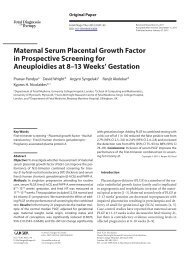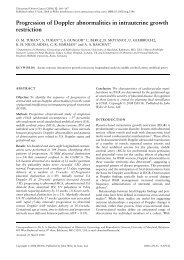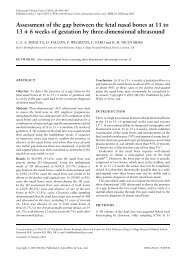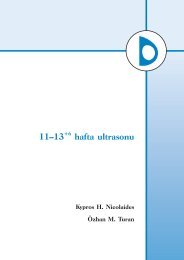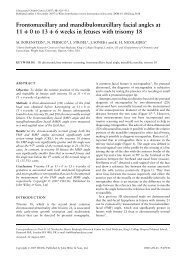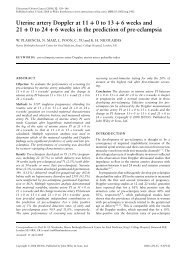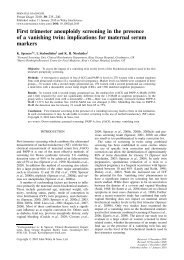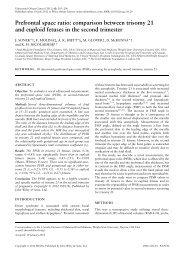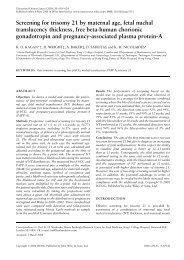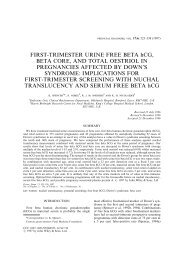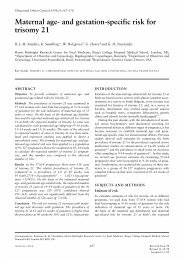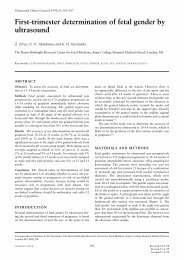Three-dimensional sonographic calculation of the volume of ...
Three-dimensional sonographic calculation of the volume of ...
Three-dimensional sonographic calculation of the volume of ...
Create successful ePaper yourself
Turn your PDF publications into a flip-book with our unique Google optimized e-Paper software.
Ultrasound Obstet Gynecol 2009; 33: 530–537<br />
Published online 26 March 2009 in Wiley InterScience (www.interscience.wiley.com). DOI: 10.1002/uog.6343<br />
<strong>Three</strong>-<strong>dimensional</strong> <strong>sonographic</strong> <strong>calculation</strong> <strong>of</strong> <strong>the</strong> <strong>volume</strong><br />
<strong>of</strong> intracranial structures in growth-restricted and<br />
appropriate-for-gestational age fetuses<br />
A. BENAVIDES-SERRALDE*, E. HERNÁNDEZ-ANDRADE*, J. FERNÁNDEZ-DELGADO*,<br />
W. PLASENCIA†, M. SCHEIER*, F. CRISPI*, F. FIGUERAS*, K. H. NICOLAIDES† and<br />
E. GRATACÓS*<br />
*Fetal and Perinatal Medicine Research Group, Department <strong>of</strong> Maternal-Fetal Medicine, Institut Clínic de Ginecologia, Obstetrícia i<br />
Neonatologia (ICGON), Hospital Clínic, Institut d’Investigacions Biomediques August Pi i Sunyer, University <strong>of</strong> Barcelona and Centro de<br />
Investigación Biomédica en Red de Enfermedades Raras, Instituto de Salud Carlos III (ISCIII), Barcelona, Spain and †Harris Birthright<br />
Research Centre for Fetal Medicine, King’s College Hospital, London, UK<br />
KEYWORDS:<br />
3D ultrasound; fetal brain; intrauterine growth restriction; <strong>volume</strong> <strong>calculation</strong><br />
ABSTRACT<br />
Objectives To evaluate <strong>the</strong> feasibility and reproducibility<br />
<strong>of</strong> <strong>volume</strong> segmentation <strong>of</strong> fetal intracranial structures<br />
using three-<strong>dimensional</strong> (3D) ultrasound imaging, and<br />
to estimate differences in <strong>the</strong> <strong>volume</strong> <strong>of</strong> intracranial<br />
structures between intrauterine growth-restricted (IUGR)<br />
and appropriate-for-gestational age (AGA) fetuses.<br />
Methods Total intracranial, frontal, thalamic and cerebellar<br />
<strong>volume</strong>s were measured using 3D ultrasound<br />
imaging and Virtual Organ Computer-aided AnaLysis<br />
(VOCAL) in 39 IUGR and 39 AGA fetuses matched for<br />
gestational age, at 28–34 weeks <strong>of</strong> gestation. Volumes<br />
<strong>of</strong>, and ratios between, structures were estimated, and<br />
differences between IUGR and AGA fetuses were calculated.<br />
Volume measurements were performed by two<br />
observers, and interobserver and intraobserver intraclass<br />
correlation coefficients (ICCs) were calculated for each<br />
structure.<br />
Results Volumes were satisfactorily obtained in all<br />
fetuses. All net <strong>volume</strong>s except those for <strong>the</strong> thalamus<br />
(P = 0.23) were significantly smaller (P = 0.001) in IUGR<br />
fetuses. After adjusting <strong>volume</strong>s for biparietal diameter <strong>the</strong><br />
frontal <strong>volume</strong> was significantly smaller (P = 0.02) and<br />
<strong>the</strong> thalamic <strong>volume</strong> significantly greater (P = 0.03) in<br />
IUGR fetuses than in AGA fetuses. Significant intergroup<br />
differences in <strong>the</strong> ratios between structures were found<br />
only in those involving <strong>the</strong> frontal region. Interobserver<br />
ICCs were as follows: total intracranial 0.97 (95% CI,<br />
0.92–0.98), cerebellar 0.69 (95% CI, 0.44–0.75), frontal<br />
0.66 (95% CI, 0.42–0.79) and thalamic 0.54 (95% CI,<br />
0.37–0.72).<br />
Conclusions IUGR fetuses show differences in <strong>the</strong><br />
<strong>volume</strong> <strong>of</strong> intracranial structures compared with AGA<br />
fetuses, with <strong>the</strong> largest difference found in <strong>the</strong> frontal<br />
region. These differences might be explained by in-utero<br />
processes <strong>of</strong> neural reorganization induced by chronic<br />
hypoxia. Copyright © 2009 ISUOG. Published by John<br />
Wiley & Sons, Ltd.<br />
INTRODUCTION<br />
Although intrauterine growth-restricted (IUGR) fetuses<br />
develop protective mechanisms, such as increased blood<br />
flow and oxygen uptake, <strong>the</strong>y have an increased risk <strong>of</strong><br />
developing signs <strong>of</strong> brain damage at birth 1–3 . The brain<br />
is particularly sensitive to changes in oxygen and glucose<br />
concentration. Studies performed in neonates and<br />
in young adults born with intrauterine growth restriction<br />
have shown that signs <strong>of</strong> neurological damage can be manifested<br />
later in life as low scores in neurodevelopmental<br />
tests and reduced cognitive function 4–6 . Neonatal studies<br />
using brain biometry and <strong>volume</strong> segmentation have<br />
demonstrated <strong>the</strong> existence <strong>of</strong> selective growth restriction<br />
in certain brain regions 7,8 , which could explain<br />
subsequent alterations in neurodevelopment. Whe<strong>the</strong>r<br />
<strong>the</strong>se changes occur in utero is unknown.<br />
Correspondence to: Dr E. Hernández-Andrade, Fetal and Perinatal Medicine Research Group, Department <strong>of</strong> Maternal-Fetal Medicine,<br />
Hospital Clínic, University <strong>of</strong> Barcelona, Sabino de Arana 1, Edificio Helios 2, 08028 Barcelona, Spain<br />
(e-mail: EHERNANDEZ@clinic.ub.es)<br />
Accepted: 31 October 2008<br />
Copyright © 2009 ISUOG. Published by John Wiley & Sons, Ltd.<br />
ORIGINAL PAPER
Brain <strong>volume</strong> in growth-restricted and appropriate-for-gestational age fetuses 531<br />
Prenatal assessment <strong>of</strong> <strong>the</strong> fetal head/brain is usually<br />
performed using two-<strong>dimensional</strong> (2D) ultrasound<br />
biometric measurements. Recently, 3D ultrasound imaging<br />
has been gradually introduced as a valuable complementary<br />
tool in fetal evaluation, <strong>of</strong>fering <strong>the</strong> possibility<br />
<strong>of</strong> calculating fetal organ <strong>volume</strong>s and providing extra<br />
information on growth and maturation 9 . Virtual Organ<br />
Computer-aided AnaLysis (VOCAL) has been used to<br />
describe normal reference values for brain and cerebellar<br />
<strong>volume</strong>s throughout gestation 10,11 . However, no information<br />
has been reported on brain <strong>volume</strong> in IUGR<br />
fetuses and, apart from <strong>the</strong> cerebellum 11 ,<strong>the</strong>reareno<br />
reports <strong>of</strong> segmentation <strong>of</strong> o<strong>the</strong>r fetal intracranial structures.<br />
The importance <strong>of</strong> this lack <strong>of</strong> information became<br />
apparent when studies in neonatal brain suggested that<br />
different intracranial areas could be selectively affected in<br />
intrauterine growth restriction 12 .<br />
Our group has previously demonstrated <strong>the</strong> existence <strong>of</strong><br />
regional vascular redistribution processes in IUGR fetuses,<br />
as measured by pulsed Doppler ultrasound imaging<br />
<strong>of</strong> different brain arteries 13 , and evaluation <strong>of</strong> brain<br />
blood perfusion by means <strong>of</strong> power Doppler ultrasound<br />
examination and fractional moving blood <strong>volume</strong><br />
estimation 14 . We postulated that <strong>the</strong>se changes might<br />
correlate with changes in growth and <strong>volume</strong> <strong>calculation</strong><br />
<strong>of</strong> different brain regions. In <strong>the</strong> present study we<br />
aimed, first, to evaluate <strong>the</strong> feasibility and reproducibility<br />
<strong>of</strong> <strong>volume</strong> segmentation <strong>of</strong> fetal intracranial structures<br />
using 3D ultrasound imaging and, second, to analyze<br />
<strong>the</strong> possible existence <strong>of</strong> differences between IUGR and<br />
appropriate-for-gestational age (AGA) fetuses.<br />
METHODS<br />
A group <strong>of</strong> 39 IUGR and 39 AGA fetuses matched<br />
by gestational age (± 1 week) were studied. Intrauterine<br />
growth restriction was defined as an estimated fetal<br />
weight < 10 th centile according to local standards 15 and<br />
a pulsatility index in <strong>the</strong> umbilical artery > 95 th centile 16 .<br />
The protocol was approved by <strong>the</strong> ethics committees <strong>of</strong><br />
<strong>the</strong> two participating centers and informed consent was<br />
obtained from <strong>the</strong> parents. Volume collection was done in<br />
<strong>the</strong> two centers and <strong>volume</strong> <strong>calculation</strong>s were performed<br />
in Barcelona.<br />
All ultrasound examinations were performed using a<br />
Voluson 730 Expert (GE Healthcare, Milwaukee, WI,<br />
USA) ultrasound machine with a 4–8-MHz curvilinear<br />
probe and an internal device for automatic acquisition <strong>of</strong><br />
frames for <strong>volume</strong> reconstruction. Routine 2D ultrasound<br />
examination for fetal anatomical evaluation and standard<br />
fetal biometry, including biparietal diameter (BPD) and<br />
head circumference (HC), was performed.<br />
Brain <strong>volume</strong>s were obtained by trained operators and<br />
were stored on digital devices for fur<strong>the</strong>r analysis. The<br />
<strong>volume</strong> sample box was adjusted to include <strong>the</strong> complete<br />
fetal head and no zoom magnification was used. The<br />
<strong>volume</strong> sweep angle was set at 80 ◦ and <strong>the</strong> highest quality<br />
<strong>of</strong> acquisition was selected. Two brain <strong>volume</strong>s were<br />
acquired from each patient. The first was obtained from<br />
a cross-sectional view <strong>of</strong> <strong>the</strong> fetal skull at <strong>the</strong> level <strong>of</strong> <strong>the</strong><br />
BPD plane. With this <strong>volume</strong>, a clear perspective <strong>of</strong> <strong>the</strong><br />
frontal region, total intracranial region and thalamus was<br />
obtained. The second <strong>volume</strong> was obtained from <strong>the</strong> same<br />
axial plane with a discrete anterior inclination <strong>of</strong> 15–20 ◦<br />
to avoid ultrasound shadowing <strong>of</strong> <strong>the</strong> petrous process and<br />
obtain a clear image <strong>of</strong> <strong>the</strong> cerebellum. All <strong>volume</strong>s were<br />
acquired in <strong>the</strong> axial view; thus, for <strong>the</strong> multiplanar display,<br />
Box A corresponded to <strong>the</strong> axial plane, Box B to <strong>the</strong><br />
coronal plane and Box C to <strong>the</strong> sagittal plane. The acquisition<br />
process was repeated until <strong>the</strong> operator was satisfied<br />
with <strong>the</strong> <strong>volume</strong>s. Fetal brain scans were performed in <strong>the</strong><br />
absence <strong>of</strong> maternal and fetal movements.<br />
Volume <strong>calculation</strong>s were made <strong>of</strong>fline by two operators<br />
(one <strong>of</strong> whom was blinded to <strong>the</strong> clinical characteristics<br />
(J.F.-D.)). The total intracranial, frontal, thalamic and<br />
cerebellar <strong>volume</strong>s were segmented manually using 4D<br />
View <strong>of</strong>fline analysis s<strong>of</strong>tware and VOCAL (GE Healthcare).<br />
The total intracranial <strong>volume</strong> was selected as <strong>the</strong><br />
standard with which to compare all o<strong>the</strong>r structures and<br />
to allow comparison <strong>of</strong> our results with those already<br />
published for normal fetuses 10 . The frontal lobe was<br />
selected because this region has previously been shown to<br />
be reduced in growth-restricted neonates 7 . The thalamus<br />
was selected for its importance in connecting almost all<br />
neural centers, and <strong>the</strong> cerebellum for its implication in<br />
motor control.<br />
In 10 <strong>volume</strong>s <strong>of</strong> <strong>the</strong> frontal lobe three different levels<br />
<strong>of</strong> spacing for <strong>the</strong> rotational method were tested, 30 ◦ (six<br />
images), 15 ◦ (12 images) and 9 ◦ (20 images). We did<br />
not find differences in <strong>the</strong> <strong>volume</strong> <strong>calculation</strong> when 12 or<br />
20 images were used (mean ± SD, 33.4 ± 13.6 cm 3 vs.<br />
32.7 ± 11.7 cm 3 ), but <strong>the</strong> time for delineating 20 images<br />
was almost double that for 12 images (range, 3–5 min<br />
vs. 7–9 min). Using six images increased <strong>the</strong> variability<br />
<strong>of</strong> <strong>the</strong> <strong>volume</strong> <strong>calculation</strong> (mean ± SD, 38.4 ± 21.2 cm 3 ).<br />
Based on <strong>the</strong>se findings, we opted for a rotation step <strong>of</strong><br />
15 ◦ . Figures 1 and 2 show <strong>the</strong> complete set <strong>of</strong> images used<br />
to construct and calculate <strong>the</strong> <strong>volume</strong> <strong>of</strong> <strong>the</strong> fontal lobe<br />
and <strong>the</strong> thalamus. The rotation process was started in an<br />
axial view at 0 ◦ and finished in <strong>the</strong> same plane at 180 ◦ ,<br />
with an angle <strong>of</strong> 90 ◦ corresponding to a coronal view <strong>of</strong><br />
<strong>the</strong> structure. The last image, corresponding to 180 ◦ , was<br />
not included in <strong>the</strong> <strong>volume</strong> <strong>calculation</strong> as it represents a<br />
mirror image <strong>of</strong> <strong>the</strong> 0 ◦ image (Figure 3).<br />
The boundaries for <strong>the</strong> total intracranial <strong>volume</strong> were<br />
defined anteriorly, posteriorly and laterally by <strong>the</strong> inner<br />
wall <strong>of</strong> <strong>the</strong> skull and inferiorly by <strong>the</strong> floor <strong>of</strong> <strong>the</strong> skull.<br />
Frontal region boundaries were delineated anteriorly and<br />
laterally by <strong>the</strong> inner wall <strong>of</strong> <strong>the</strong> skull, inferiorly by <strong>the</strong><br />
floor <strong>of</strong> <strong>the</strong> skull and posteriorly by <strong>the</strong> Sylvian fissure<br />
(lateral fissure). This structure can be recognized from an<br />
axial view <strong>of</strong> <strong>the</strong> fetal head at <strong>the</strong> level <strong>of</strong> <strong>the</strong> BPD<br />
and is considered as <strong>the</strong> posterior landmark for <strong>the</strong><br />
frontal lobe 7,17 . To complete <strong>the</strong> posterior delineation<br />
<strong>of</strong> <strong>the</strong> frontal region, a transverse plane connecting<br />
<strong>the</strong> two lateral Sylvian fissures was drawn, excluding<br />
<strong>the</strong> thalami. The thalamus was defined by following<br />
its contours and crossing <strong>the</strong> midline at two points in<br />
Copyright © 2009 ISUOG. Published by John Wiley & Sons, Ltd. Ultrasound Obstet Gynecol 2009; 33: 530–537.
532 Benavides-Serralde et al.<br />
Figure 1 Images obtained with a rotation step <strong>of</strong> 15 ◦ using Virtual Organ Computer-aided AnaLysis (VOCAL) to delineate <strong>the</strong> frontal lobe<br />
for <strong>volume</strong> <strong>calculation</strong> and reconstruction.<br />
order to obtain a single <strong>volume</strong>. The cerebellum was<br />
delineated by following <strong>the</strong> middle line and <strong>the</strong> contours<br />
<strong>of</strong> <strong>the</strong> cerebellar hemispheres (Figure 4). Volumes were<br />
expressed in cm 3 . For each structure, <strong>the</strong> <strong>volume</strong> was<br />
estimated twice and <strong>the</strong> mean <strong>of</strong> <strong>the</strong>se two measurements<br />
was considered as its representative value.<br />
Ratios between <strong>the</strong> evaluated regions were calculated.<br />
Differences in net <strong>volume</strong>s were analyzed using Student’s<br />
t-test and differences in ratios between IUGR and AGA<br />
fetuses were analyzed with <strong>the</strong> Mann–Whitney U-test.<br />
To test <strong>the</strong> hypo<strong>the</strong>sis that IUGR fetuses show smaller<br />
regional brain <strong>volume</strong>s than controls independently <strong>of</strong><br />
head size, a multiple regression model was constructed<br />
for each region, in which <strong>the</strong> dependent variable was<br />
regional brain <strong>volume</strong> and <strong>the</strong> independent variable was<br />
a dichotomized IUGR variable. In addition, BPD was<br />
included in <strong>the</strong> model as a covariate to adjust for <strong>the</strong><br />
effect <strong>of</strong> intrauterine growth restriction on overall head<br />
biometry. Thus, <strong>the</strong> model coefficient for <strong>the</strong> IUGR<br />
variable could be interpreted as <strong>the</strong> adjusted difference<br />
in regional brain <strong>volume</strong>s between cases and controls,<br />
assuming <strong>the</strong> same overall head size. Each regression<br />
model was checked for <strong>the</strong> assumptions <strong>of</strong> regression.<br />
P < 0.05 was considered significant.<br />
To assess interobserver and intraobserver reliability,<br />
a two-way random and a two-way mixed model,<br />
respectively, were used and single-measure intraclass<br />
correlation coefficients (ICCs) for absolute agreement<br />
were calculated. The following benchmarks were used<br />
for ICC characterization: slight reliability (0–0.2), fair<br />
reliability (0.21–0.4), moderate reliability (0.41–0.6),<br />
substantial reliability (0.61–0.8) and almost perfect<br />
reliability (0.81–1.0) 18 . Statistical analysis was performed<br />
using Statistical Package for <strong>the</strong> Social Sciences version<br />
14.0 (SPSS Inc., Chicago, IL, USA) and MedCalc version<br />
8.0 (MedCalc S<strong>of</strong>tware, Mariakerke, Belgium) statistical<br />
s<strong>of</strong>tware.<br />
RESULTS<br />
Volume measurements from all structures were obtained<br />
in all fetuses. The demographic characteristics <strong>of</strong> <strong>the</strong><br />
groups studied are shown in Table 1. Low umbilical artery<br />
pH values and 5-min Apgar scores were more frequent in<br />
<strong>the</strong> IUGR group but <strong>the</strong>se differences were not statistically<br />
significant.<br />
There were three fetal and two neonatal deaths in <strong>the</strong><br />
IUGR group. The three cases that resulted in fetal death<br />
had shown reversed atrial flow in <strong>the</strong> ductus venosus and,<br />
due to extreme prematurity, <strong>the</strong> parents had opted against<br />
<strong>the</strong> fetuses being delivered. The two cases that resulted<br />
in neonatal death had shown an increased pulsatility<br />
Copyright © 2009 ISUOG. Published by John Wiley & Sons, Ltd. Ultrasound Obstet Gynecol 2009; 33: 530–537.
Brain <strong>volume</strong> in growth-restricted and appropriate-for-gestational age fetuses 533<br />
Figure 2 Images obtained with a rotation step <strong>of</strong> 15 ◦ using Virtual Organ Computer-aided AnaLysis (VOCAL) to delineate <strong>the</strong> thalamus for<br />
<strong>volume</strong> <strong>calculation</strong> and reconstruction.<br />
15°<br />
0°<br />
30°<br />
45°<br />
60°<br />
75°<br />
90° 105°<br />
120°<br />
135°<br />
150°<br />
165°<br />
Figure 3 Diagram showing 15 ◦ rotation steps for measurement <strong>of</strong><br />
<strong>the</strong> <strong>volume</strong> <strong>of</strong> <strong>the</strong> frontal lobe starting from <strong>the</strong> axial plane. Note<br />
that <strong>the</strong> starting image at 0 ◦ and <strong>the</strong> final one at 180 ◦ are mirror<br />
images, and so <strong>the</strong> last image (dashed line) is not included in <strong>the</strong><br />
<strong>volume</strong> <strong>calculation</strong>.<br />
180°<br />
index in <strong>the</strong> ductus venosus but present atrial flow.<br />
Both <strong>of</strong> <strong>the</strong>se fetuses developed signs <strong>of</strong> intraventricular<br />
hemorrhage.<br />
Substantial to almost perfect intraobserver reliability<br />
was observed for all regions. Total intracranial, frontal<br />
and cerebellar regions showed similar figures for<br />
interobserver reliability. The only structure showing<br />
moderate interobserver measurement reliability was <strong>the</strong><br />
thalamus (Table 2).<br />
The BPD and HC were significantly smaller in <strong>the</strong> IUGR<br />
group than in AGA fetuses (Table 3). No statistically<br />
significant differences were found in <strong>the</strong> HC/BPD ratio<br />
between <strong>the</strong> two groups. Differences in <strong>the</strong> net <strong>volume</strong>s <strong>of</strong><br />
<strong>the</strong> studied structures are shown in Table 3. All <strong>volume</strong><br />
estimations, except those for <strong>the</strong> thalamic area, were<br />
significantly reduced in <strong>the</strong> IUGR group.<br />
Table 3 also illustrates <strong>the</strong> ratios between <strong>the</strong> different<br />
regions. In IUGR fetuses <strong>the</strong> frontal <strong>volume</strong> was reduced,<br />
and <strong>the</strong> thalamic <strong>volume</strong> was increased, in relation<br />
to <strong>the</strong> total intracranial <strong>volume</strong>. However, statistically<br />
significant differences were found only in ratios including<br />
<strong>the</strong> frontal <strong>volume</strong>.<br />
After adjustment for BPD (Table 4), <strong>the</strong> thalamic<br />
<strong>volume</strong> was found to be significantly larger, and <strong>the</strong><br />
frontal <strong>volume</strong> significantly smaller, in IUGR fetuses,<br />
whereas total intracranial and cerebellar <strong>volume</strong>s did not<br />
differ from those in AGA fetuses.<br />
DISCUSSION<br />
The results <strong>of</strong> this study suggest that fetuses with severe<br />
intrauterine growth restriction have reduced frontal and<br />
increased thalamic <strong>volume</strong>s in relation to <strong>the</strong> total<br />
intracranial <strong>volume</strong>. These differences persisted when <strong>the</strong><br />
<strong>volume</strong>s were adjusted by <strong>the</strong> BPD <strong>of</strong> each fetus. The<br />
Copyright © 2009 ISUOG. Published by John Wiley & Sons, Ltd. Ultrasound Obstet Gynecol 2009; 33: 530–537.
534 Benavides-Serralde et al.<br />
Figure 4 Final <strong>volume</strong> reconstructions <strong>of</strong> <strong>the</strong> frontal (a), total intracranial (b), thalamic (c) and cerebellar (d) regions using Virtual Organ<br />
Computer-aided AnaLysis (VOCAL).<br />
Table 1 Clinical characteristics <strong>of</strong> appropriate-for-gestational age (AGA) and intrauterine growth-restricted (IUGR) fetuses<br />
Variable AGA (n = 39) IUGR (n = 39) P<br />
Gestational age at examination (weeks + days) 28 + 1 (23 + 5 to 34 + 0) 28 + 3 (24 + 0 to 34 + 1) NS<br />
Maternal age (years) 27 (18–41) 29 (21–42) NS<br />
Gestational age at birth (weeks + days) 38 + 3 (36 + 2 to 40 + 5) 29 + 0 (25 + 2 to 34 + 6) 0.016<br />
Birth weight (g) 3205 ± 455 (2610–3850) 1012 ± 394 (430–1808) 0.026<br />
Survival rate 39/39 (100) 34/39 (87.2) 0.05<br />
5-min Apgar score < 7 1 5 NS<br />
Umbilical artery pH < 7.15 1 6 NS<br />
Values are median (range), mean ± SD (range) or n (%). NS, not significant.<br />
Table 2 Interobserver and intraobserver reliability <strong>of</strong> <strong>volume</strong><br />
measurement <strong>of</strong> fetal intracranial structures expressed as intraclass<br />
correlation coefficients (ICCs)<br />
ICC (95% CI)<br />
Volume Interobserver Intraobserver<br />
Intracranial 0.97 (0.92–0.98) 0.97 (0.95–0.98)<br />
Cerebellar 0.69 (0.44–0.75) 0.76 (0.54–0.89)<br />
Frontal 0.66 (0.42–0.79) 0.78 (0.55–0.86)<br />
Thalamic 0.54 (0.37–0.72) 0.68 (0.48–0.84)<br />
existence <strong>of</strong> regional brain <strong>volume</strong> variations in IUGR<br />
fetuses is in agreement with previous reports evaluating<br />
regional brain <strong>volume</strong>s with magnetic resonance imaging<br />
(MRI) 12 , and brain areas calculated by <strong>sonographic</strong><br />
biometric estimations 7 in IUGR preterm neonates. Our<br />
data are also in line with <strong>the</strong> concept <strong>of</strong> reorganization <strong>of</strong><br />
<strong>the</strong> developing human brain in <strong>the</strong> context <strong>of</strong> pathological<br />
conditions or lesions 19 –21 .<br />
The issue <strong>of</strong> whe<strong>the</strong>r brain reorganization is reflected<br />
in major changes in whole brain <strong>volume</strong>, at least in<br />
preterm IUGR fetuses, remains unclear. In agreement<br />
Copyright © 2009 ISUOG. Published by John Wiley & Sons, Ltd. Ultrasound Obstet Gynecol 2009; 33: 530–537.
Brain <strong>volume</strong> in growth-restricted and appropriate-for-gestational age fetuses 535<br />
Table 3 Cranial measurements, net <strong>volume</strong> <strong>calculation</strong>s and <strong>volume</strong> ratios in appropriate-for-gestational age (AGA) and intrauterine<br />
growth-restricted (IUGR) fetuses<br />
Parameter AGA (n = 39) IUGR (n = 39) P<br />
Biparietal diameter (cm) 7.1 ± 0.9 6.5 ± 0.9 < 0.0001<br />
Head circumference (cm) 25.8 ± 3.0 23.6 ± 3.0 < 0.0001<br />
Volume (cm 3 )<br />
Total intracranial 194.2 ± 55.1 (96.3–328.0) 157.3 ± 51.9 (79.17–287.3) 0.001<br />
Frontal 32.2 ± 11.6 (11.2–62.0) 22.9 ± 9.9 (7.8–43.8) 0.001<br />
Thalamic 1.5 ± 0.9 (0.8–4.5) 1.3 ± 0.8 (0.5–4.2) 0.23<br />
Cerebellar 6.0 ± 2.1 (2.8–11.3) 5.0 ± 1.7 (1.7–8.6) 0.001<br />
Ratio between structures<br />
Intracranial/thalamic 129.46 121.00 0.2<br />
Intracranial/cerebellar 32.36 31.46 0.8<br />
Intracranial/frontal 6.03 6.86 0.001<br />
Frontal/thalamic 21.46 17.61 0.001<br />
Frontal/cerebellar 5.36 4.58 0.0122<br />
Thalamic/cerebellar 0.25 0.26 0.289<br />
Values are mean, mean ± SD or mean ± SD (range).<br />
Table 4 Differences in regional brain <strong>volume</strong> adjusted by biparietal<br />
diameter between intrauterine growth-restricted (IUGR) and<br />
appropriate-for-gestational age (AGA) fetuses<br />
Brain region <strong>volume</strong> (95% CI) P<br />
Frontal −3.61 (−6.67 to −0.55) 0.02<br />
Thalamic 0.28 (0.03–0.54) 0.03<br />
Intracranial −4.59 (−14.78 to 5.60) 0.37<br />
Cerebellar 0.23 (−0.32 to 0.77) 0.41<br />
<strong>volume</strong>, <strong>volume</strong> difference (IUGR − AGA).<br />
with <strong>the</strong> present study, Tolsa et al. failedtodemonstrate<br />
a reduction in <strong>the</strong> total brain <strong>volume</strong> adjusted by HC in<br />
premature infants who were growth-restricted in utero<br />
compared with AGA neonates, as measured by MRI 12 .In<br />
contrast, Duncan et al. showed a significant reduction<br />
in <strong>the</strong> total brain <strong>volume</strong> in mildly growth-restricted<br />
neonates born near to term, although <strong>the</strong>se authors did<br />
not adjust by cranial measurements 8 . The differences<br />
between <strong>the</strong>se studies might <strong>the</strong>refore be explained by<br />
<strong>the</strong> different methods used for <strong>calculation</strong>, but could also<br />
reflect <strong>the</strong> distinct impact <strong>of</strong> <strong>the</strong> frontal lobe on total brain<br />
<strong>volume</strong> between early gestational ages and those at <strong>the</strong><br />
end <strong>of</strong> pregnancy, when <strong>the</strong> frontal lobe comprises almost<br />
one-third <strong>of</strong> <strong>the</strong> total brain <strong>volume</strong> 7 .<br />
Our results in <strong>the</strong> frontal region are in agreement with<br />
those <strong>of</strong> ano<strong>the</strong>r study by Makhoul et al., which found<br />
significant differences in <strong>the</strong> frontal lobe area between<br />
IUGR and AGA neonates, also with measurements<br />
obtained using ultrasound imaging 7 . Fur<strong>the</strong>rmore, our<br />
findings are also in line with long-term follow-up<br />
studies <strong>of</strong> children with intrauterine growth restriction<br />
showing abnormal neurological functions typically or<br />
partly associated with frontal networking, such as<br />
creativity and language, and memory performance and<br />
learning abilities 22 . These alterations have been reported<br />
to be strongly associated with impaired frontal lobe<br />
function and abnormal neural connections with <strong>the</strong><br />
hippocampus 22 . O<strong>the</strong>r abnormalities associated with a<br />
reduction in <strong>the</strong> frontal lobe are trisomy 21 23 , epilepsy 24 ,<br />
severe mental retardation 25 , schizophrenia 26 and fragile-X<br />
gene syndrome 27 .<br />
The second interesting finding <strong>of</strong> this study was<br />
<strong>the</strong> relative increase in thalamic <strong>volume</strong> in relation to<br />
o<strong>the</strong>r intracranial structures in IUGR fetuses. To our<br />
knowledge, <strong>the</strong>re are no previous reports on <strong>volume</strong><br />
estimation <strong>of</strong> this structure in fetuses. The thalamus<br />
is a gray matter structure made up <strong>of</strong> myelinated<br />
fibers from which most sensory information reaches<br />
<strong>the</strong> cerebral cortex. Using MRI segmentation, Zacharia<br />
et al. found that <strong>the</strong> relative <strong>volume</strong> <strong>of</strong> <strong>the</strong> basal ganglia<br />
and thalamus was higher in preterm than in term-born<br />
infants 28 . These data are in agreement with neonatal<br />
observations reported by Tolsa et al., who concluded that<br />
intrauterine growth restriction affects mainly <strong>the</strong> cortical<br />
white matter ra<strong>the</strong>r than <strong>the</strong> subcortical gray matter 12 .<br />
The observed differences in <strong>the</strong> thalamic <strong>volume</strong> in IUGR<br />
and AGA fetuses, despite being encouraging, should be<br />
interpreted with caution. Despite obtaining acceptable<br />
reliability results, a considerable source <strong>of</strong> error should<br />
be expected when tracing this area manually. Fur<strong>the</strong>r<br />
studies with a larger population and using o<strong>the</strong>r methods<br />
<strong>of</strong> segmentation or imaging modalities are needed to<br />
confirm <strong>the</strong>se results.<br />
There are several possible explanations for <strong>the</strong> distinct<br />
size <strong>of</strong> intracranial structures in IUGR fetuses. Studies<br />
using animal models and voxel-based morphometry have<br />
demonstrated that early brain insults <strong>of</strong>ten lead to<br />
extensive neural reorganization <strong>of</strong> <strong>the</strong> gray and white<br />
brain matter, which can be expressed as an increment or<br />
reduction in specific brain areas 19,21,29 . These changes<br />
may reflect <strong>the</strong> existence <strong>of</strong> regional differences in<br />
susceptibility to brain insults 19 . Alternatively, or in<br />
combination, hemodynamic brain redistribution could be<br />
a major pathophysiological mechanism behind regional<br />
reorganization <strong>of</strong> <strong>the</strong> brain 12,14 . IUGR fetuses show<br />
significant temporal differences in <strong>the</strong> blood flow patterns<br />
Copyright © 2009 ISUOG. Published by John Wiley & Sons, Ltd. Ultrasound Obstet Gynecol 2009; 33: 530–537.
536 Benavides-Serralde et al.<br />
<strong>of</strong> different brain arteries in <strong>the</strong> vasodilatory response<br />
to hypoxia 13,30 . This mechanism has been fur<strong>the</strong>r<br />
demonstrated by regional differences in brain blood flow<br />
perfusion related to <strong>the</strong> severity and progression <strong>of</strong> <strong>the</strong><br />
growth restriction insult 14 . Whereas IUGR fetuses at early<br />
stages <strong>of</strong> deterioration show an overall increment in blood<br />
flow perfusion, mainly manifested in <strong>the</strong> frontal lobe,<br />
those at later stages shift this increment to <strong>the</strong> basal<br />
ganglia.<br />
Several methodological issues and potential limitations<br />
in this study deserve mention. The present study provides<br />
evidence that segmentation <strong>of</strong> fetal brain structures<br />
obtained by 3D ultrasound examination can be achieved<br />
with reasonable reproducibility. The intracranial regions<br />
studied were chosen on <strong>the</strong> basis <strong>of</strong> previous reports<br />
in neonates with growth restriction 7,12 ; however, as<br />
experience is gained and image resolution improves,<br />
fur<strong>the</strong>r areas could be studied. These relatively ill defined<br />
structures have been delineated following anatomical<br />
descriptions and in accordance with reports using MRI.<br />
Owing to <strong>the</strong> lack <strong>of</strong> ‘gold standards’, <strong>the</strong> accuracy <strong>of</strong> <strong>the</strong><br />
<strong>calculation</strong>s performed cannot be assessed.<br />
However, this study did not intend to calculate absolute<br />
values <strong>of</strong> intracranial structures but ra<strong>the</strong>r to assess<br />
<strong>the</strong> existence <strong>of</strong> differences in relative <strong>volume</strong> between<br />
cases and controls. Total intracranial <strong>volume</strong> <strong>calculation</strong>s<br />
in AGA fetuses and reproducibility scores were in<br />
agreement with those reported by Roelfsema et al. 31 .<br />
One major factor that can affect <strong>volume</strong> <strong>calculation</strong>s<br />
is <strong>the</strong> method used for segmentation <strong>of</strong> <strong>the</strong> intracranial<br />
structures. Methods for total automatic segmentation in<br />
3D ultrasound <strong>volume</strong>s are lacking. In this study we used<br />
VOCAL, which provides a semiautomatic delineation that<br />
frequently requires manual adjustments by <strong>the</strong> operator.<br />
VOCAL was selected instead <strong>of</strong> a multiplanar technique<br />
because this method requires less time to calculate<br />
<strong>volume</strong>s and has acceptable reproducibility 9 . However,<br />
<strong>the</strong> possibility that <strong>the</strong> use <strong>of</strong> a multiplanar technique<br />
might provide greater accuracy in <strong>the</strong> <strong>calculation</strong> <strong>of</strong><br />
absolute <strong>volume</strong>s cannot be excluded.<br />
The results <strong>of</strong> this study suggest that <strong>the</strong> fetal brain,<br />
exposed to a specific injury, does not respond in <strong>the</strong> same<br />
manner in all <strong>of</strong> its regions. It should be considered as a<br />
dynamic structure, which varies in its response depending<br />
on <strong>the</strong> onset, duration and intensity <strong>of</strong> <strong>the</strong> injury. These<br />
different responses might have different neurological<br />
manifestations. The study also shows that different fetal<br />
brain regions can be reliably delineated and analyzed.<br />
The combination <strong>of</strong> morphological and hemodynamic<br />
changes might help to identify specific patterns <strong>of</strong> neural<br />
damage, and could allow implementation <strong>of</strong> optimal<br />
clinical management to reduce or avoid possible abnormal<br />
neurodevelopment later in life.<br />
In conclusion, when adjusted for overall head biometry,<br />
IUGR fetuses show a reduction in <strong>the</strong> frontal and an<br />
increment in <strong>the</strong> thalamic <strong>volume</strong>s compared with AGA<br />
fetuses matched by gestational age. These results illustrate<br />
<strong>the</strong> modifications induced by in-utero growth restriction<br />
in <strong>the</strong> anatomical configuration <strong>of</strong> <strong>the</strong> fetal brain. The<br />
differences may be due to <strong>the</strong> neural reorganization<br />
processes produced by regional changes in blood flow<br />
redistribution to <strong>the</strong>se areas, among o<strong>the</strong>r mechanisms.<br />
Future studies on 3D ultrasound <strong>volume</strong> <strong>calculation</strong>s<br />
<strong>of</strong> <strong>the</strong>se and o<strong>the</strong>r intracranial fetal structures could<br />
provide valuable information on how <strong>the</strong>se changes may<br />
be correlated with long-term neurodevelopment.<br />
ACKNOWLEDGMENTS<br />
This study was supported by research grants from Cerebra,<br />
Foundation for <strong>the</strong> Brain-Injured Child (Carmar<strong>the</strong>n,<br />
Wales, UK); The Thrasher Research Fund (Salt Lake<br />
City, UT, USA); Marie Curie Host Fellowships for Early<br />
Stage Researchers (FETAL-MED-019707-2); and Fondo<br />
de Investigación Sanitaria PI060347 (Spain). E.H.-A. was<br />
supported by grants from <strong>the</strong> Ministry <strong>of</strong> Education and<br />
Science (SB2003-0293), ‘Juan de la Cierva’ program for<br />
<strong>the</strong> development <strong>of</strong> Research Centers, Spain.<br />
REFERENCES<br />
1. Padilla-Gomes NF, Enríquez G, Acosta-Rojas R, Perapoch J,<br />
Hernandez-Andrade E, Gratacos E. Prevalence <strong>of</strong> neonatal<br />
ultrasound brain lesions in premature infants with and<br />
without intrauterine growth restriction. Acta Paediatr 2007;<br />
96: 1582–1587.<br />
2. Fouron JC, Gosselin J, Amiel-Tison C, Infante-Rivard C,<br />
Fouron C, Skoll A, Veilleux A. Correlation between prenatal<br />
velocity waveforms in <strong>the</strong> aortic isthmus and neurodevelopmental<br />
outcome between <strong>the</strong> ages <strong>of</strong> 2 and 4 years. Am J Obstet<br />
Gynecol 2001; 184: 630–636.<br />
3. Gonzalez JM, Stamilio DM, Ural S, Macones GA, Odibo AO.<br />
Relationship between abnormal fetal testing and adverse<br />
perinatal outcomes in intrauterine growth restriction. Am J<br />
Obstet Gynecol 2007; 196: e48–e51.<br />
4. Tideman E, Marsál K, Ley D. Cognitive function in young<br />
adults following intrauterine growth restriction with abnormal<br />
fetal aortic blood flow. Ultrasound Obstet Gynecol 2007; 29:<br />
614–618.<br />
5. Upadhyay SK, Kant L, Singh TB, Bhatia BD. Neurobehavioural<br />
assessment <strong>of</strong> newborns. Electromyogr Clin Neurophysiol 2000;<br />
40: 113–117.<br />
6. Majnemer A, Rosenblatt B, Riley PS. Influence <strong>of</strong> gestational<br />
age, birth weight, and asphyxia on neonatal neurobehavioral<br />
performance. Pediatr Neurol 1993; 9: 181–186.<br />
7. Makhoul IR, Soudack M, Goldstein I, Smolkin T, Tamir A,<br />
Sujov P. Sonographic biometry <strong>of</strong> <strong>the</strong> frontal lobe in normal and<br />
growth-restricted neonates. Pediatr Res 2004; 55: 877–883.<br />
8. Duncan KR, Issa B, Moore R, Baker PN, Johnson IR,<br />
Gowland PA. A comparison <strong>of</strong> fetal organ measurements by<br />
echo-planar magnetic resonance imaging and ultrasound. BJOG<br />
2005; 112: 43–49.<br />
9. Kalache KD, Espinoza J, Chaiworapongsa T, Londono J,<br />
Schoen ML, Treadwell MC, Lee W, Romero R. <strong>Three</strong>-<strong>dimensional</strong><br />
ultrasound fetal lung <strong>volume</strong> measurement: a systematic<br />
study comparing <strong>the</strong> multiplanar method with <strong>the</strong> rotational<br />
(VOCAL) technique. Ultrasound Obstet Gynecol 2003; 21:<br />
111–118.<br />
10. Chang CH, Yu CH, Chang FM, Ko HC, Chen HY. The<br />
assessment <strong>of</strong> normal fetal brain <strong>volume</strong> by 3-D ultrasound.<br />
Ultrasound Med Biol 2003; 29: 1267–1272.<br />
11. Chang CH, Chang FM, Yu CH, Ko HC, Chen HY. Assessment<br />
<strong>of</strong> fetal cerebellar <strong>volume</strong> using three-<strong>dimensional</strong> ultrasound.<br />
Ultrasound Med Biol 2000; 26: 981–988.<br />
Copyright © 2009 ISUOG. Published by John Wiley & Sons, Ltd. Ultrasound Obstet Gynecol 2009; 33: 530–537.
Brain <strong>volume</strong> in growth-restricted and appropriate-for-gestational age fetuses 537<br />
12. Tolsa CB, Zimine S, Warfield SK, Freschi M, Sancho<br />
Rossignol A, Lazeyras F, Hanquinet S, Pfizenmaier M, Huppi<br />
PS. Early alteration <strong>of</strong> structural and functional brain development<br />
in premature infants born with intrauterine growth<br />
restriction. Pediatr Res 2004; 56: 132–138.<br />
13. Figueroa-Diesel H, Hernandez-Andrade E, Acosta-Rojas R,<br />
Cabero L, Gratacos E. Doppler changes in <strong>the</strong> main fetal brain<br />
arteries at different stages <strong>of</strong> hemodynamic adaptation in severe<br />
intrauterine growth restriction. Ultrasound Obstet Gynecol<br />
2007; 30: 297–302.<br />
14. Hernandez-Andrade E, Figueroa-Diesel H, Jansson T, Rangel-<br />
Nava H, Gratacos E. Changes in regional fetal cerebral blood<br />
flow perfusion in relation to hemodynamic deterioration in<br />
severely growth-restricted fetuses. Ultrasound Obstet Gynecol<br />
2008; 32: 71–76.<br />
15. Figueras F, Meler E, Iraola A, Eixarch E, Coll O, Figueras J,<br />
Francis A, Gratacos E, Gardosi J. Customized birthweight<br />
standards for a Spanish population. Eur J Obstet Gynecol<br />
Reprod Biol 2008; 136: 34–38.<br />
16. Arduini D, Rizzo G. Normal values <strong>of</strong> pulsatility index from<br />
fetal vessels: a cross-sectional study on 1556 healthy fetuses.<br />
JPerinatMed1990; 18: 165–172.<br />
17. Gray H. The nervous system. In Gray’s Anatomy, Standring S<br />
(ed). Churchill Livingston: Edinburgh, 2004; 643–669.<br />
18. Fleiss J. Statistical Methods for Rates and Proportions (2 nd edn).<br />
John Wiley: New York, 1981.<br />
19. Gramsbergen A. Neural compensation after early lesions: a<br />
clinical view <strong>of</strong> animal experiments. Neurosci Biobehav Rev<br />
2007; 31: 1088–1094.<br />
20. Staudt M. Reorganization <strong>of</strong> <strong>the</strong> developing human brain<br />
following periventricular white matter lesions. Neurosci<br />
Biobehav Rev 2007; 31: 150–156.<br />
21. Nosarti C, Giouroukou E, Healy E, Rifkin L, Walshe M,<br />
Reichenberg A, Chitnis X, Williams SC, Murray RM. Grey<br />
and white matter distribution in very preterm adolescents<br />
mediates neurodevelopmental outcome. Brain 2008; 3:<br />
205–217.<br />
22. Geva R, Eshel R, Leitner Y, Fattal Valevski A, Harel S. Neuropsychological<br />
outcome <strong>of</strong> children with intrauterine growth<br />
restriction: a 9-year prospective study. Pediatrics 2006; 118:<br />
91–100.<br />
23. Winter TC, Ostrovsky AA, Komarniski CA, Uhrich SB. Cerebellar<br />
and frontal lobe hypoplasia in fetuses with trisomy 21:<br />
usefulness as combined US markers. Radiology 2000; 214:<br />
533–538.<br />
24. Lawson JA, Vogrin S, Bleasel AF, Cook MJ, Bye AM. Cerebral<br />
and cerebellar <strong>volume</strong> reduction in children with intractable<br />
epilepsy. Epilepsia 2000; 41: 1456–1462.<br />
25. Hiraiwa M, Nonaka C, Sekiyama M, Mishima M,<br />
Kobayashi M, Abe T, Fujii R, Yasukochi H. Changes in frontal<br />
lobe size with age. ACT study in children. Acta Radiol Suppl<br />
1986; 369: 680–682.<br />
26. Harvey I, Ron MA, Du Boulay G, Wicks D, Lewis SW,<br />
Murray RM. Reduction <strong>of</strong> cortical <strong>volume</strong> in schizophrenia on<br />
magnetic resonance imaging. Psychol Med 1993; 23: 591–604.<br />
27. Mazzocco MM, Hagerman RJ, Cronister-Silverman A,<br />
Pennington BF. Specific frontal lobe deficits among women with<br />
<strong>the</strong> fragile-X gene. J Am Acad Child Adolesc Psychiatry 1992;<br />
31: 1141–1148.<br />
28. Zacharia A, Zimine Z, Lovblad K, Warfield S, Thoeny H,<br />
Ozdoba C, Bossi E, Kreis R, Boesch C, Schroth G, Huppi PS.<br />
Early assessment <strong>of</strong> brain maturation by MR imaging<br />
segmentation in neonates and premature infants. Am J<br />
Neuroradiol 2006; 27: 972–977.<br />
29. Staudt M. Reorganization <strong>of</strong> <strong>the</strong> developing human brain<br />
following periventricular white matter lesions. Neurosci<br />
Biobehav Rev 2007; 31: 150–156.<br />
30. Dubiel M, Gunnarsson GO, Gudmundsson S. Blood redistribution<br />
in <strong>the</strong> fetal brain during chronic hypoxia. Ultrasound<br />
Obstet Gynecol 2002; 20: 117–121.<br />
31. Roelfsema NM, Hop WC, Boito SM, Wladimir<strong>of</strong>f JW. <strong>Three</strong><strong>dimensional</strong><br />
<strong>sonographic</strong> measurement <strong>of</strong> normal fetal brain<br />
<strong>volume</strong> during <strong>the</strong> second half <strong>of</strong> pregnancy. Am J Obstet<br />
Gynecol 2004; 190: 275–280.<br />
Copyright © 2009 ISUOG. Published by John Wiley & Sons, Ltd. Ultrasound Obstet Gynecol 2009; 33: 530–537.



